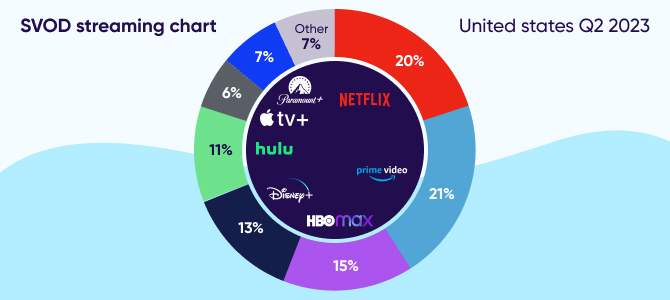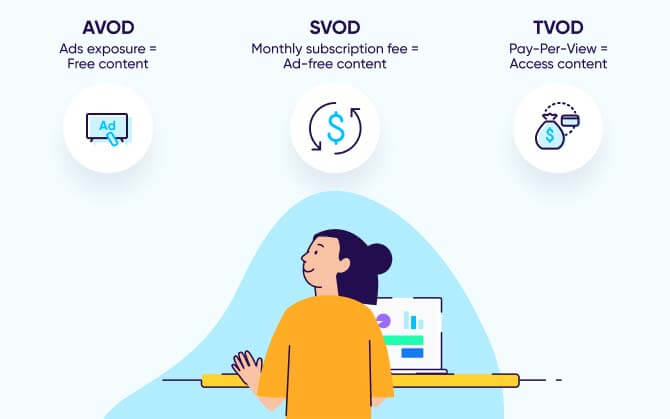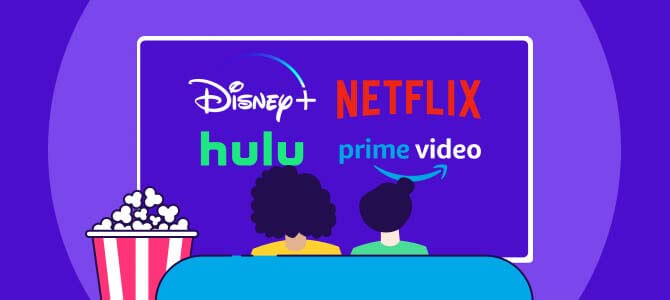
SVOD (Subscription Video on Demand)
SVOD is a way of giving subscribers unlimited access to on-demand video content, in exchange for a regular fee. Popular platforms like Netflix, Disney+, and Amazon Prime use this model to monetize their content.
What is SVOD?
Short for subscription video on demand, SVOD is a popular monetization model for OTT video platforms. Subscribers pay a flat subscription fee in return for unlimited access to a massive library of video content, ad free. Think of it as a SaaS subscription, but for video content.
The subscription fee may be charged at any fixed interval, but it’s most often a monthly or annual payment. Users benefit from unlimited content access, while the platform enjoys predictable revenue leading to higher LTV.
SVOD is most associated with entertainment platforms — think Netflix, Disney+, Prime Video, or Apple TV+, for instance. But it’s also used for other genres like:
- eLearning
- eSports (gaming)
- Sports
- Fitness, health, and wellness
Chances are, you subscribe to at least one SVOD service — just like 83% of US households. Worldwide, the number of SVOD subscriptions is forecast to reach nearly 1.7 billion by 2027 (bearing in mind that one subscriber may have multiple subscriptions).
Given the massive popularity of SVOD platforms, you may be wondering…
Can SVOD replace cable TV?

Since 2010, cable TV penetration in the US has dropped from 88% to 66%, and nearly 30% of American and Canadian viewers plan to cut the cord in the coming months.
And it’s a similar story worldwide, as SVOD platforms reel in users through quality content at affordable prices. At the same time, the rise of smartphones, smart TVs, and SVOD apps, all supported by ever-faster internet speeds, make these services more accessible than ever.
But, while SVOD is clearly eating into the market share of cable TV, not everyone is ready to cut the cord just yet: it looks like the two services will co-exist for a while longer.
SVOD platforms
Some of the most popular video streaming OTT platforms monetize their on-demand content using SVOD. Here are the major players:
- Netflix: Boasting well over 70 million subscribers in the US and Canada alone, and commanding a 20% US market share, Netflix has achieved global domination thanks to its diverse mix of original and curated content. However, subscriber numbers have dropped recently due to rising fees and growing competition.
- Prime Video: With big-name shows like Lord of the Rings: The Rings of Power, Reacher, and Fleabag, Amazon’s streaming platform actually overtook Netflix in the first half of 2023, grabbing a 21% market share.
- Max: The former HBO Max platform has scooped a 15% market share in the US, thanks to its vast library of HBO classics like The Sopranos as well as newer hits like Killing Eve and White Lotus.
- Disney+: The home to all movies and shows created by Disney, this platform has a 13% market share in the US.
- Hulu: With an 11% share in the US market, this platform provides TV shows, movies, and live TV as well.

These big names face competition from the likes of Apple TV+, Paramount Plus, Showtime, ESPN+, and Peacock, which are all working to offer unique content at affordable prices.
The advantages and disadvantages of SVOD
As we’ve seen, millions of users around the world are convinced of the benefits of SVOD — and with new services springing up all the time, it’s clearly an attractive model for providers too. But are there any downsides? Let’s investigate.
Advantages of SVOD
1 – Predictable, recurring revenue
Subscription revenue keeps coming month-over-month or year-over-year, which means you’ve got a guaranteed revenue stream to help run and grow your OTT platform.
2 – Pricing control
There are no pricing restrictions when it comes to SVOD models. You can choose to offer different pricing tiers, device-exclusive plans, or even varying plans based on the location you’re serving content in.
In a nutshell, your revenue is in your control and you can tweak it as you go according to ARPU and churn. Just make sure your content is worth the fee!
3 – Brand loyalty
When you create or curate content that resonates with a core group of users, or is exclusively available through your platform, this will more often than not translate into loyal subscribers who also recommend your service to others.
This means you can count on long-term recurring revenue as well as expansion of your user base (without you having to pay for it!).
4 – Audience connection
All those regular subscribers aren’t just a source of income — they also provide a deep well of customer insight. You have the chance to really get to know your users, observe their viewing behavior, and engage with them, helping you shape a service that gives them more of what they love. Which, in turn, fuels the brand loyalty described above.
Disadvantages of SVOD
1 – Potentially smaller user base
Not everyone is willing or able to pay a recurring fee — some users prefer to watch content with ads for free (known as AVOD).
2 – Strong competition
Competition in the SVOD market is intensifying. This means not only do you have to be smart about pricing (because users may not be ready to pay for more than one subscription), you also have to invest in a constant stream of fresh, quality content users will want to watch — both of which could ultimately eat into your revenue.
Offering a time-limited discount is a popular strategy for attracting new users. But to keep them, you’ll need to be sure your offering is still competitive at full price.
3 – More expensive to acquire new users
Brand loyalty and word of mouth can only go so far. Given the competitive ecosystem and ad-based alternatives, users may be reluctant to switch to or pay for an additional streaming service, resulting in high acquisition costs. As mentioned above, you need top-quality content to win and keep subscribers — and that doesn’t come cheap.
SVOD vs. AVOD vs. TVOD

SVOD is one of the main monetization models for OTT platforms, with the others being AVOD (advertising-based video on demand) and TVOD (transactional video on demand).
Let’s understand how they differ.
AVOD
This monetization model works on payment from advertisers, while users get free access to the content they want for the “price” of watching an ad before, during, or after their chosen video.
The platforms using an AVOD model appeal to a broader audience and have the highest number of users (they’re free, after all). The best-known AVOD example is YouTube.
TVOD
With TVOD, as with AVOD, users can sign up to a platform for free, but they need to pay a one-time fee to rent or buy content.
This method works best for premium content, like the latest movie releases. For rented videos, there might be a fixed time window or cap on the number of times they can be viewed, while buying a video generally gives permanent access. Apple iTunes is an example of a platform using TVOD.
Is SVOD the right model for you?
Wondering if SVOD could help you monetize your video content? Let’s figure out if it’s the right choice for your business.
Choose SVOD if you:
- Have an extensive or niche content library that you know your target audience would be willing to pay for
- Have the funds (and willingness) to invest in creating original content regularly to update your content library
- Can spend on campaigns to acquire new subscribers (and retain them)
- Are able to manage flexible subscription plans and track complex metrics
- Are after a recurring income stream
How to get started with SVOD
Did you read the checklist above and think “That’s me!”? In that case, here’s what you need to do to start your SVOD platform:
- Select your niche and target audience, as they determine the type of content you’ll need to add to your platform (entertainment, fitness, or sports, for example).
- Select a video hosting platform with video APIs, security, cloud content delivery network (CDN), etc. Check if it lets you develop mobile and smart TV apps.
- Set up multi-CDN architecture to provide consistent content delivery even if one CDN goes down.
- Start collecting and creating engaging content to be added to the platform.
- Build a subscription website and app on the selected platform.
- Encode your videos for adaptive bitrate streaming to provide a good video watching experience, irrespective of network speeds.
- Secure your videos with DRM (digital rights management) technology to curb piracy.
- Decide on your pricing plans and the level of access each plan provides.
- Set up a paywall for your videos to get visitors to subscribe to your platform to access the content.
- Market your SVOD platform to build a subscriber base.
SVOD trends
As SVOD continues to gain popularity, here are a few trends to look out for:
SVOD meets AVOD: the hybrid approach
As competition intensifies and platforms fight to extend their audience, one model that’s gaining popularity is a hybrid one: viewers can choose between paying for an ad-free experience, or watching for free with ads. Both Netflix and Disney+ have gone down this two-tier route in a bid to capture a wider audience base.
Advertisers, of course, like the ad-supported approach: they get their brand in front of a relevant, engaged audience (as identified by the publisher — that is, the platform), and they typically only pay for actual views of their ad. For publishers, ad revenue is less predictable than that from subscriptions — but combining these two income streams can add up to a healthy profit.
Subscription fatigue
Have you ever read a glowing review of a TV show, only to discover it’s on a platform you can’t access? Or maybe you’ve taken out a subscription purely to dive into that one must-watch series?
With so much great content on offer, the question is, how many services can one user realistically subscribe to? Increasingly, customers will grab an introductory offer, binge-watch their favorites, and then move on. For platforms, providing an outstanding experience at the right price will be key to lowering their churn rate.
A competitive media landscape
We’ve seen that SVOD platforms are competing with each other, as well as with traditional TV. But, for younger generations in particular, they’re also up against social media and gaming as entertainment options. Services will need to up their game to engage with these consumers, who expect an interactive experience that goes beyond passive TV viewing.
Key takeaways
- SVOD gives users unlimited access to a platform’s video content for a regular subscription fee. This monetization model is popular with platforms including Netflix, Prime Video, and Disney+.
- SVOD differs from AVOD (monetized through ads) and TVOD (monetized through fixed content fees for renting or buying).
- This model brings in recurring revenue and gives you full control of pricing. It also enables you to connect with users and build a loyal subscriber base. On the flipside, some customers prefer a free, ad-supported model, plus user acquisition can be costly in such a competitive market.
- You should consider SVOD only if you have an extensive library of niche content, are willing to spend in order to get and retain subscribers, and can manage and track flexible pricing plans.
- To launch an SVOD service, you’ll need to identify your target audience, source engaging content, and build a reliable platform to deliver it. You also need to work out your pricing plan and develop a subscription website and app.
- The SVOD landscape is becoming increasingly competitive and users are quick to churn. To combat this, platforms are moving toward a hybrid model offering subscription and ad-supported tiers.




